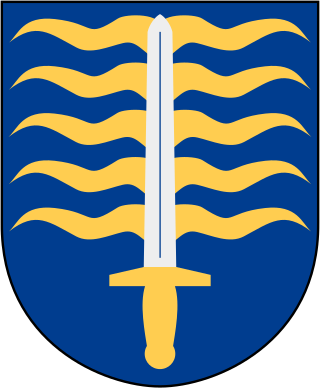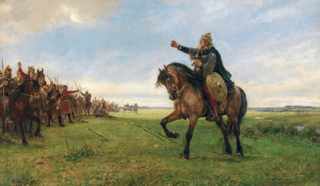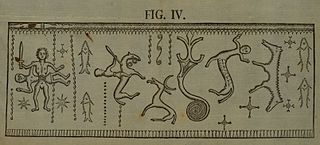
Tyrfing, also rendered as Tirfing or Tyrving, was a magic sword in Norse mythology, which features in the Tyrfing Cycle, which includes a poem from the Poetic Edda called Hervararkviða, and the Hervarar saga. The name is also used in the saga to denote the Goths.

Samsø is a Danish island in the Kattegat 15 kilometers (9.3 mi) off the Jutland Peninsula. Samsø is located in Samsø municipality. The community has 3,724 inhabitants (2017) called Samsings and is 114 km² in area. Due to its central location, the island was used during the Viking Age as a meeting place. The etymology of the island's name is unknown.

Hlöðskviða, known in English as The Battle of the Goths and Huns and occasionally known by its German name Hunnenschlachtlied, is an Old Norse heroic poem found in Hervarar saga ok Heiðreks. Many attempts have been made to try to fit it with known history, but it is an epic poem, telescoping and fictionalising history to a large extent; some verifiable historical information from the time are place names, surviving in Old Norse forms from the period 750–850, but it was probably collected later in Västergötland.

Hervarar saga ok Heiðreks is a legendary saga from the 13th century combining matter from several older sagas in Germanic heroic legend. It tells of wars between the Goths and the Huns during the 4th century. The final part of the saga, which was likely composed separately from and later than the rest, is a source for Swedish medieval history.

Örvar-Oddr is a legendary hero about whom an anonymous Icelander wrote a fornaldarsaga in the latter part of the 13th century. Örvar-Odds saga, the Saga of Örvar-Odd, became very popular and contains old legends and songs. He also appears in Hervarar saga and, concerning the battle on Samsø, in Gesta Danorum.

Hjalmar and Ingeborg were a legendary Swedish duo. The male protagonist Hjalmar and his duel for Ingeborg figures in the Hervarar saga and in Orvar-Odd's saga, as well as in Gesta Danorum, Lay of Hyndla and a number of Faroese ballads. Hjalmar never lost a battle until meeting a berserker wielding the cursed sword Tyrfing.

Hervör is the name shared by two female characters in the Tyrfing Cycle, presented in The Saga of Hervör and Heidrek with parts found in the Poetic Edda. The first, the Viking Hervör, challenged her father Angantýr's ghost in his gravemound for his cursed sword Tyrfing. She had a son, Heidrek, father of the other Hervör. The second Hervör was a commander killed in battle with her brother.
Heidrek or Heiðrekr is one of the main characters in the cycle about the magic sword Tyrfing. He appears in the Hervarar saga, and probably also in Widsith, together with his sons Angantyr (Incgentheow) and Hlöð (Hlith), and Hlöð's mother Sifka (Sifeca). The etymology is heiðr, meaning "honour", and rekr, meaning "ruler, king".

Svafrlami was in the H and U version of the Hervarar saga the son of Sigrlami, who was the son of Odin. In the R version, Svafrlami is called Sigrlami and his parentage is not given. Svafrlami was the king of Gardariki and the first owner of the magic sword Tyrfing.

Arngrim was a berserker, who features in Hervarar saga, Gesta Danorum, Lay of Hyndla, a number of Faroese ballads and Orvar-Odd's saga in Norse mythology.

Hervararkviða, is an Old Norse poem from the Hervarar saga, and which is sometimes included in editions of the Poetic Edda.
The Tyrfing Cycle is a collection of Norse legends, unified by the shared element of the magic sword Tyrfing. Two of the legends are found in the Poetic Edda, and the Hervarar saga can be seen as a compilation of these legends.
Árheimar was a capital of the Goths, according to the Hervarar saga. The saga states that it was located at Danparstaðir, which is identified with the ruins of Kamjans'ke Horodyšče, near Kamianka-Dniprovska in southern Ukraine.
Eyfura was a princess in Norse mythology, who married Arngrim and had twelve sons. In all accounts, her twelve sons would be slain by the Swedish champion Hjalmar and his friend Orvar-Odd.
Munarvágr was a location on the southern shore of Samsø, which is mentioned in the legendary sagas Hervarar saga and Ragnar Lodbrok's saga.
The Dagling or Dögling dynasty was a legendary clan of the petty kingdom Ringerike in what today is Norway. It was descended from a Dag the Great.

The Haddingjar refers on the one hand to Germanic heroic legends about two brothers by this name, and on the other hand to possibly related legends based on the Hasdingi, the royal dynasty of the Vandals. The accounts vary greatly.
Humli is a legendary king of the Huns who appears in the Hervarar Saga. He is the Grandfather of Hlod, illegitimate son of Heidrek, King of the Goths.

In Germanic heroic legend, Elgfróði (Elk-Fróði) is the half-man, half-elk elder brother of the hero Bödvar Bjarki and Thorir Houndsfoot. The name is also used to describe mythical creatures with his perceived form, which have been seen as a Norse variant of a centaur, although it is not clear if he was intended to be depicted with two or four legs.
Sifka or Sifeca is a Hun princess in Norse mythology, the mother of the warrior Hlöd by Heidrek, King of the Geats.











